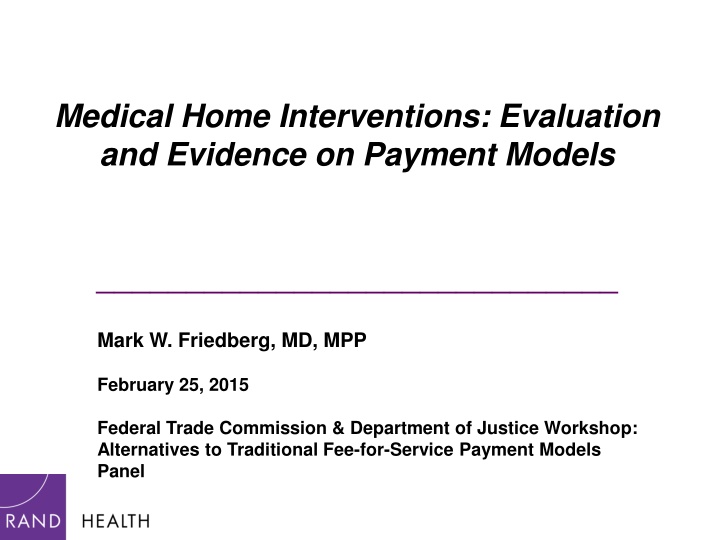
Medical Home Interventions and Payment Models
Explore the evaluation and evidence on alternative payment models for medical homes, including defining the concept, key intervention elements, and the relationship between interventions, models, and patient care. An example from the Pennsylvania Chronic Care Initiative illustrates how such interventions are implemented and measured for outcomes.
Download Presentation

Please find below an Image/Link to download the presentation.
The content on the website is provided AS IS for your information and personal use only. It may not be sold, licensed, or shared on other websites without obtaining consent from the author. If you encounter any issues during the download, it is possible that the publisher has removed the file from their server.
You are allowed to download the files provided on this website for personal or commercial use, subject to the condition that they are used lawfully. All files are the property of their respective owners.
The content on the website is provided AS IS for your information and personal use only. It may not be sold, licensed, or shared on other websites without obtaining consent from the author.
E N D
Presentation Transcript
Medical Home Interventions: Evaluation and Evidence on Payment Models _____________________________ Mark W. Friedberg, MD, MPP February 25, 2015 Federal Trade Commission & Department of Justice Workshop: Alternatives to Traditional Fee-for-Service Payment Models Panel
Defining Medical Home There is no such thing as the medical home Instead, multiple definitions of medical homes Best not to assume that two people talking about the medical home are talking about the same thing First question to ask: Do you mean medical home as a model of primary care practice, or as an intervention applied to primary care practices? Some studies evaluate models, others evaluate interventions Changing how a primary care practice is paid is an intervention 2
Key ingredients of medical home interventions New resources for primary care practices Technical assistance, coaching In-kind contributions Enhanced payment, many possible forms: Per member per-month supplemental payment Shared savings Fee-for-service rate uplift New requirements for primary care practices Practice transformation / adopt new capabilities Demonstrate medical homeness 3
Relationship between intervention, model, and patient care Some practices adopt model, to varying extents Intervention applied Changes in patient care 4
Relationship between intervention, model, and patient care Some practices adopt model, to varying extents Intervention applied Changes in patient care Some practices still might adopt model Intervention not applied Changes in patient care 5
Example of a medical home intervention: Southeast region of the Pennsylvania Chronic Care Initiative 32 practices, 6 payers, 3-year intervention: June 2008 - 2011 Inputs: Technical assistance Per member per-month bonus payments tied to NCQA recognition level Requirements: Obtain NCQA medical home recognition (level 1 or higher) within first 12 months Participate in learning collaborative activities and report registry- based performance data Friedberg MW, Schneider EC, Rosenthal MB, Volpp KG, Werner RM. Association between participation in a multipayer medical home intervention and changes in quality, utilization, and costs of care. JAMA 2014;311(8):815-825. 6
Among pilot practices, there was structural transformation targeting quality 100% 90% 80% 70% 60% 50% Pre Post 40% 30% 20% 10% 0% Frequent meetings about quality Registry of high-risk patients Outreach for A1c testing E-prescribing 7 All changes significant at P<0.05
Limited changes in patient care, relative to comparison practices Domain Quality Findings Statistically significant improvement on 1 process measure of diabetes care (nephropathy monitoring) Trends towards improvement on 3 additional process measures of diabetes care No statistically significant differences No statistically significant differences Utilization Costs Findings were robust to numerous sensitivity analyses: Alternative functional forms, attribution rules Patient, provider, and insurer subpopulations Including analyses restricted to patients with diabetes: results were the same And including analyses* restricted to patients in the top 10% of Charlson scores: results were the same 8 *Supplemental analysis we performed in April 2014
What can we take away from this evaluation? It is possible for a medical home intervention to have limited effects on patient care over a 3-year period Findings similar to evaluations of other early medical home interventions* So it s not a sure thing However, not all medical home pilots are alike, and implementers are refining their approaches Ongoing medical home interventions have different components, including different payment models These ongoing pilots may produce different results *See: Werner RM, et al. Med Care 2013;51(6):487-493 Rosenthal MB, et al. JAMA Intern Med 2013;173(20):1907-1913 Fifield J, et al. J Gen Intern Med 2013;28(6):778-86 9
We can use evidence to refine medical home interventions Within 2-3 years, the results of another 20-30 pilots should be published, including 3 giant CMS pilots Heterogeneity creates opportunity Different intervention recipes may lead to different outcomes Evaluations will help us identify the key ingredients, including which payment models seem to work best But right now, we do not have an evidence base that identifies the best ways to reform payment in medical home interventions In particular, no published evaluations of interventions that include shared savings
Thank you Contact: Mark Friedberg, MD, MPP mfriedbe@rand.org 11
Evaluations of medical home models and interventions: some recent examples Evaluations of models Higgins et al, AJMC 2014 Wang et al, J Public Health Manag Prac 2014 David et al, HSR 2014 Kern et al, Ann Intern Med 2014 Paustian et al, HSR 2014 Wholey et al, Minnesota Dept Health 2014 Van Hasselt et al, HSR 2014 Evaluations of interventions Friedberg et al, JAMA 2014 Rosenthal et al, JAMA Intern Med 2013 Werner et al, Med Care 2013 Fifield et al, JGIM 2013 Evidence reviews on interventions Jackson et al, Ann Intern Med 2013 Peikes et al, AJMC 2012 Broadly speaking, the findings of these two types of evaluations are not the same. This is not surprising. Remember, they are not asking the same question. 12
